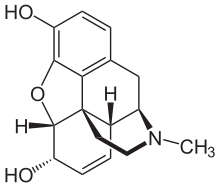Oramorph
 |
|
 |
|
| Clinical data | |
|---|---|
| Pronunciation | /ˈmɔːrfiːn/ |
| Trade names | MScontin, Oramorph, Sevredol, and others |
| AHFS/Drugs.com | Monograph |
| Pregnancy category |
|
| Dependence liability |
Physical: High Psychological: Moderate |
| Addiction liability |
High |
| Routes of administration |
Inhalation (smoking), insufflation (snorting), by mouth (PO), rectal, subcutaneous (SC), intramuscular (IM), intravenous (IV), epidural, and intrathecal (IT) |
| Drug class | opiate |
| ATC code | |
| Legal status | |
| Legal status |
|
| Pharmacokinetic data | |
| Bioavailability | 20% to 40% (by mouth), 36% to 71% (rectally), 100% (IV/IM) |
| Protein binding | 30% to 40% |
| Metabolism | Hepatic 90% |
| Onset of action | 5 min (IV), 15 min (IM), 20 min (PO) |
| Biological half-life | 2 h to 3 h |
| Duration of action | 3 h to 7 h |
| Excretion | Renal 90%, biliary 10% |
| Identifiers | |
|
|
| CAS Number |
|
| PubChem CID | |
| IUPHAR/BPS | |
| DrugBank | |
| ChemSpider | |
| UNII | |
| KEGG | |
| ChEBI | |
| ChEMBL | |
| ECHA InfoCard | 100.000.291 |
| Chemical and physical data | |
| Formula | C17H19NO3 |
| Molar mass | 285.34 g/mol |
| 3D model (JSmol) | |
| Solubility in water | HCl & sulf.: 60 mg/mL (20 °C) |
|
|
|
|
Morphine is a pain medication of the opiate type which is found naturally in a number of plants and animals. It acts directly on the central nervous system (CNS) to decrease the feeling of pain. It can be taken for both acute pain and chronic pain. Morphine is frequently used for pain from myocardial infarction and during labour. It can be given by mouth, by injection into a muscle, by injecting under the skin, intravenously, into the space around the spinal cord, or rectally. Maximum effect is around 20 minutes when given intravenously and 60 min when given by mouth, while duration of effect is between 3 h and 7 h. Long-acting formulations also exist.
Potentially serious side effects include a decreased respiratory effort and low blood pressure. Morphine has a high potential for addiction and abuse. If the dose is reduced after long-term use, withdrawal may occur. Common side effects include drowsiness, vomiting, and constipation. Caution is advised when used during pregnancy or breast feeding, as morphine will affect the baby.
Morphine was first isolated between 1803 and 1805 by Friedrich Sertürner. This is generally believed to be the first isolation of an active ingredient from a plant.Merck began marketing it commercially in 1827. Morphine was more widely used after the invention of the hypodermic syringe in 1853–1855. Sertürner originally named the substance morphium after the Greek god of dreams, Morpheus, as it has a tendency to cause sleep.
...
Wikipedia
